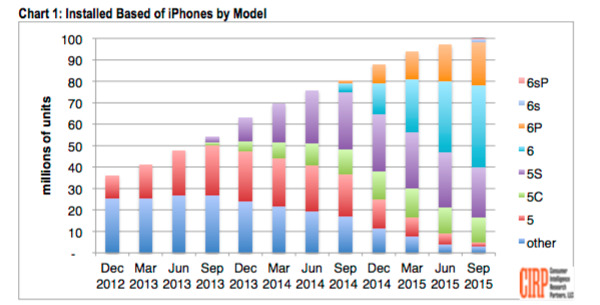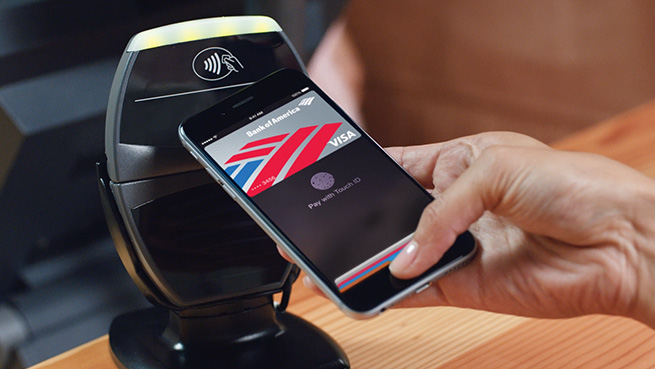According to research by Consumer Intelligence Research Partners, the installed base of iPhones in the United States has now reached 101 million. Somewhat incredibly, the majority of these phones now in use are iPhone 6 (or newer) models with support for Apple Pay via Touch ID.

Source: CIRP, via Tim Bradshaw
By the end of the September quarter, CIRP noted that 58 million iPhone 6 and 6 Plus were in use in the U.S., while another 4 million iPhone 6s and 6s Plus models entered into service in the last weekend of the quarter.
Mike Levin, CIRP's Co-Founder, noted that iPhone 6 models sold an estimated 60 million units across their first launch year, in contrast to the estimated 28 million iPhone 5s sales that occured during its first year on sale.
"The analysis shows the continued strength of the iPhone 6 and 6 Plus, now one year old," Levin wrote.
CIRP's data is based on analysis of "iPhone buyers, their new model selections, their prior phones, and overlaying Apple iPhone sales data adjusted to the U.S. market."

While iPhone sales continue to grow, the rate of growth of the U.S. installed base during the September quarter is slowing, from 6 percent growth last year to 4 percent growth this year.
Levin noted that "as the U.S. market matures, Apple has fewer first-time smartphone buyers to add to their base, and faces the challenge of attracting loyal Android users."
Inciting switchers
Separate research by Ericsson Mobility indicated that shaking users loose from their current platform is rather difficult. Their report noted that "around 80 percent of Android and iOS users are loyal to their operating system."
However, that firm also found that during Apple's annual iPhone introduction, defection rates from Android and Windows doubles, as Android loyalty rates dip from 82 percent to 76 percent.
Apple's Tim Cook noted in the company's September earnings report that "we recorded the highest rate on record for Android switchers last quarter at 30 percent." Because that only included one weekend of new iPhone 6s sales, this indicates that Apple's ability to incite switching from other platforms remains significantly higher than Ericsson's data found.
Too many! Cook spoils the scoop
Cook also noted, "we also look at the number of people that have upgraded, that were in the installed base prior to iPhone 6 and 6 Plus, and that number is in the low 30 percentages, so we feel like we have a very open field in front of us."
Cook has a more accurate view of Apple's installed base for iPhones than outside researchers trying to ascertain the company's sales mix and installed base, but he was also commenting on global sales, not just those in the U.S.
As Apple's share of the U.S. installed base ratchets upward, it has drawn its attention toward selling iPhones in other markets, having principally focused upon China but increasingly new emerging markets including India and Vietnam. Apple's ability to attract large numbers of premium buyers outside of the U.S. is also virtually unprecedented
Apple's ability to attract large numbers of premium buyers outside of the U.S. is also virtually unprecedented. Microsoft's Windows Mobile, Palm and BlackBerry all struggled to gain significant market share outside of North America prior to the iPhone's release, making it very difficult for those companies to survive Apple's assault concentrated initially on the U.S. market. A new upstart platform in the U.S. would have a very difficult challenge in taking on Apple's global platform strength today.
Conversely, Google's services have been shut out of China entirely, and its efforts to gain more control over Android in other markets, including India--the primary target of its Android One inititive--have been rejected by Android licensees as well.
Where do all those old iPhones go?
Perhaps harder to understand in the CIRP data is the idea that more users are not holding on to older iPhone models, or passing them on to other users. It seems plausible to think that more older models of iPhones are still in active use. CIRP indicates that only fewer than 5 million iPhone 5 or older models are still in use.
That's a massive decrease given that iPhone 5 itself was "only" released three years ago. However, it also had the shortest lifespan of any iPhone model, being replaced by an enhanced iPhone 5c model the following year.
Roughly 10 million iPhone 5c models are currently in use, making it a very popular model despite an intense scoffing campaign that branded it a "flop" for not outselling the fancier, more expensive iPhone 5s it was sold next to, even though it successfully outsold other Android flagships on the market and sold more units than all BlackBerry or Windows phones put together.
Apple's data on the uptake of new versions of iOS, which currently shows that 67 percent of its installed base is now running iOS 9 (as of November 16), also shows that just 9 percent are running a version older than iOS 8.
That means less than one tenth of Apple's users either failed to upgrade or can't upgrade because they have a device older than iPhone 4s, the oldest supported by iOS 8 and iOS 9. This appears to corroborate CIRP's data showing a rapid decline in active use of older models as the entire user base upgrades to modern equipment.
Data from Mixpanel shows even greater adoption of iOS 9, currently depicting 77.6 percent adoption, and only 4.3 percent using a version of iOS older than last year's iOS 8.
That firm's statistics on hardware models shows 56 percent adoption for iPhone 6 models, 36 percent using some model of iPhone 5, 4.8 percent using iPhone 4s, and less than 2.5 percent using iPhone 4 or older, models that are not capable of running iOS 8 or iOS 9. In contrast to CIRP, Mixpanel data appears to be based on worldwide user analysis, not just users in the U.S.
By way of contrast, Google reports that as of this month, only 0.3 percent of its Google Play users have installed Android 6.0 (introduced alongside iOS 9), and only 25.6 percent are using Android 5.0, which was released a year ago (next to iOS 8). The majority, 66 percent, are using some version of Android 4.x, first released over two years ago and dating back to 2011 (when Apple introduced iOS 5).
